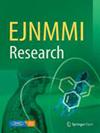Radiosynthesis automation, non-human primate biodistribution and dosimetry of K+ channel tracer [11C]3MeO4AP
IF 3.1
3区 医学
Q1 RADIOLOGY, NUCLEAR MEDICINE & MEDICAL IMAGING
引用次数: 0
Abstract
4-Aminopyridine (4AP) is a medication for the symptomatic treatment of multiple sclerosis. Several 4AP-based PET tracers have been developed for imaging demyelination. In preclinical studies, [11C]3MeO4AP has shown promise due to its high brain permeability, high metabolic stability, high plasma availability, and high in vivo binding affinity. To prepare for the translation to human studies, we developed a cGMP-compatible automated radiosynthesis protocol and evaluated the whole-body biodistribution and radiation dosimetry of [11C]3MeO4AP in non-human primates (NHPs). Automated radiosynthesis was carried out using a GE TRACERlab FX-C Pro synthesis module. One male and one female adult rhesus macaques were used in the study. A high-resolution CT from cranial vertex to knee was acquired. PET data were collected using a dynamic acquisition protocol with four bed positions and 13 passes over a total scan time of ~ 150 min. Based on the CT and PET images, volumes of interest (VOIs) were manually drawn for selected organs. Non-decay corrected time-activity curves (TACs) were extracted for each VOI. Radiation dosimetry and effective dose were calculated from the integrated TACs using OLINDA software. Fully automated radiosynthesis of [11C]3MeO4AP was achieved with 7.3 ± 1.2% (n = 4) of non-decay corrected radiochemical yield within 38 min of synthesis and purification time. [11C]3MeO4AP distributed quickly throughout the body and into the brain. The organs with highest dose were the kidneys. The average effective dose of [11C]3MeO4AP was 4.0 ± 0.6 μSv/MBq. No significant changes in vital signs were observed during the scan. A cGMP-compatible automated radiosynthesis of [11C]3MeO4AP was developed. The whole-body biodistribution and radiation dosimetry of [11C]3MeO4AP was successfully evaluated in NHPs. [11C]3MeO4AP shows lower average effective dose than [18F]3F4AP and similar average effective dose as other carbon-11 tracers.K+通道示踪剂[11C]3MeO4AP的放射合成自动化、非人灵长类生物分布和剂量测定
4-氨基吡啶(4AP)是一种对症治疗多发性硬化症的药物。目前已开发出几种基于 4AP 的 PET 示踪剂,用于脱髓鞘成像。在临床前研究中,[11C]3MeO4AP 因其高脑渗透性、高代谢稳定性、高血浆可用性和高体内结合亲和力而表现出良好的前景。为了做好向人体研究转化的准备,我们开发了一种与 cGMP 兼容的自动放射合成方案,并评估了 [11C]3MeO4AP 在非人灵长类动物(NHPs)体内的全身生物分布和辐射剂量学。自动放射合成是使用 GE TRACERlab FX-C Pro 合成模块进行的。研究使用了一雄一雌两只成年猕猴。采集了从头颅顶点到膝盖的高分辨率 CT。PET 数据的采集采用动态采集方案,有四个床位和 13 次扫描,总扫描时间约为 150 分钟。根据 CT 和 PET 图像,手动绘制了所选器官的感兴趣容积(VOI)。为每个感兴趣体积提取非衰减校正时间活动曲线(TAC)。使用 OLINDA 软件根据整合后的 TACs 计算辐射剂量学和有效剂量。在 38 分钟的合成和纯化时间内,实现了[11C]3MeO4AP 的全自动放射合成,非衰变校正放射化学产率为 7.3 ± 1.2% (n = 4)。[11C]3MeO4AP迅速分布于全身并进入大脑。剂量最高的器官是肾脏。[11C]3MeO4AP 的平均有效剂量为 4.0 ± 0.6 μSv/MBq。扫描过程中未观察到生命体征的明显变化。我们开发了一种与 cGMP 兼容的[11C]3MeO4AP 自动放射合成技术。成功评估了[11C]3MeO4AP在非人类动物体内的全身生物分布和辐射剂量。[11C]3MeO4AP的平均有效剂量低于[18F]3F4AP,与其他碳-11示踪剂的平均有效剂量相似。
本文章由计算机程序翻译,如有差异,请以英文原文为准。
求助全文
约1分钟内获得全文
求助全文
来源期刊

EJNMMI Research
RADIOLOGY, NUCLEAR MEDICINE & MEDICAL IMAGING&nb-
CiteScore
5.90
自引率
3.10%
发文量
72
审稿时长
13 weeks
期刊介绍:
EJNMMI Research publishes new basic, translational and clinical research in the field of nuclear medicine and molecular imaging. Regular features include original research articles, rapid communication of preliminary data on innovative research, interesting case reports, editorials, and letters to the editor. Educational articles on basic sciences, fundamental aspects and controversy related to pre-clinical and clinical research or ethical aspects of research are also welcome. Timely reviews provide updates on current applications, issues in imaging research and translational aspects of nuclear medicine and molecular imaging technologies.
The main emphasis is placed on the development of targeted imaging with radiopharmaceuticals within the broader context of molecular probes to enhance understanding and characterisation of the complex biological processes underlying disease and to develop, test and guide new treatment modalities, including radionuclide therapy.
 求助内容:
求助内容: 应助结果提醒方式:
应助结果提醒方式:


